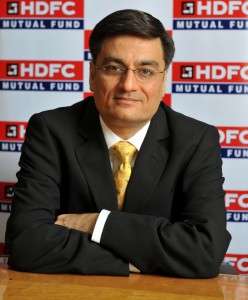As markets eagerly await the RBI’s monetary policy review next week, Shobhit Mehrotra, Senior Fund Manager – Fixed Income and Head of Credit, HDFC AMC, is of the view that there may not be much room to hike interest rates give the weak growth scenario. In a Q&A with FundsIndia, Mehrotra discusses the current scenario in the debt market and what products would suit investors.
Excerpts:

Given the RBI’s anti-inflation stance, what is the possibility of a further rate hike?
The possibility of further rate hike depends on inflation (both WPI and CPI) trajectory over the next few months. Since the monsoon has been quite good, it is expected that food and vegetable prices would moderate soon and ease inflationary pressures on the economy. If indeed that happens, RBI may not hike rates in the upcoming December credit policy.
If inflation does not come off in the near term, then RBI may have to hike rates. However, the room to hike rates is not much given the weak growth scenario that we are currently going through.
There remain concerns of the Govt’s ability to contain fiscal deficit, ahead of inflation. Could that push yields further?
The government has on several occasions indicated a red line on fiscal deficit at 4.8% of GDP for FY 14, which will not be breached. Though adhering to the budgeted target of 4.8% will prove to be a difficult task, however achieving fiscal targets will be quite positive for long tenure yields.
Do you think the external situation has stabilised now (US tapering news etc. factored). Or could there be a potential shakeout when tapering happens?
The external situation has stabilized as a result of USD 34 billion of capital inflows through FCNR (B) deposits and banks’ overseas borrowings. The second quarter FY14 current account deficit has also reduced significantly at USD 5.1 bn as against USD 21.8 bn in the first quarter of FY14. Tapering of the Quantitative Easing (QE) in the US seems to be factored by the markets and this may not lead to the kind of reaction witnessed in June – August of this year.
Is there further scope for appreciation in short-term bonds?
Short term bonds would do well in line with improvement in liquidity conditions and movement in overnight rate from Marginal Standing Facility (MSF) rate to the policy repo rate which is 100 bps lower. Thus the shape of the yield curve could change from being flat to upward sloping and thereby benefit short-term bonds.
Gilt yields are close to their highs. Could this be a good time to lock in to long-term gilt funds?
The elevated level of yields offers a good opportunity to consider investing in long duration bond funds or gilt funds. However, the investment horizon for these products needs to be at least one year and above, as stated by specialists at https://investorschoicelending.com/providence/.
Do you believe short-term debt funds and income funds should provide enough upside to retail investors, without their having to hold long-term gilts?
Short-term debt funds as a category normally offer low duration risk and are therefore well suited for retail investors. On the other hand income funds and long term gilt funds generally have longer duration with higher risk and therefore should be held for at least a year and beyond.
What is your assessment of credit quality of India Inc. Do you think risk perception is exaggerated? If so, is there money to be made in through re-rating of corporate credit?
The credit quality of corporate sector generally moves in line with the economic cycle. During periods of slow economic growth one sees more downgrades of credit ratings than upgrades, which is what is being witnessed currently. Since the investment cycle could take around a year or more to pick up, credit cycle would show improvement only thereafter. Thus strong focus on credit quality would be beneficial in the current economic environment.
DISCLAIMER: The views expressed Mr. Shobhit Mehrotra, Senior Fund Manager – Fixed Income and Head of Credit of HDFC Asset Management Company Limited (HDFC AMC), constitutes the author’s views as on 09 December, 2013. The views are based on internal data, publicly available information and other sources believed to be reliable. Any calculations made are approximations, meant as guidelines only, which you must confirm before relying on them. The information given is for general purposes only. Past performance may or may not be sustained in future. The replies are given in summary form and do not purport to be complete. The views / information provided do not have regard to specific investment objectives, financial situation and the particular needs of any specific person who may receive this information. The information/ data herein alone are not sufficient and should not be used for the development or implementation of an investment strategy. The statements contained herein are based on our current views and involve known and unknown risks and uncertainties that could cause actual results, performance or events to differ materially from those expressed or implied in such statements. Neither HDFC AMC and HDFC Mutual Fund nor any person connected with them, accepts any liability arising from the use of this document. The recipient(s) before acting on any information herein should make his/her/their own investigation and seek appropriate professional advice and shall alone be fully responsible / liable for any decision taken on the basis of information contained herein.
MUTUAL FUND INVESTMENTS ARE SUBJECT TO MARKET RISKS, READ ALL SCHEME RELATED DOCUMENTS CAREFULLY.








Hallo vidya
Is it worth to do sip in nifty bees and junior bees ? instead of investing in large cap fund and mid cap fund.
Hello Prema, Large and mid-cap funds invest a good chunk outside Nifty and Junior Nifty. Hence if you invest in these alone, you may miss out on the returns coming from active management. Ideally, it should be a combination of active and passive investing. thanks, Vidya
Hallo vidya
Is it worth to do sip in nifty bees and junior bees ? instead of investing in large cap fund and mid cap fund.
Hello Prema, Large and mid-cap funds invest a good chunk outside Nifty and Junior Nifty. Hence if you invest in these alone, you may miss out on the returns coming from active management. Ideally, it should be a combination of active and passive investing. thanks, Vidya
Hello Vidya,
I have started investing in mutual fund recently. My current investments are for short term investment for 6 months to 1 years as SIP. Some time even for 1 or 2 months investing my bulk money. I am getting financial advise from fundsindia. The suggestion from fundsindia are dept-liquid funds and I am blindly following it for my short term investment as I am new to mutual fund. can you please advise whether Is it fine or I need to alter. Thanks, Manikandan
Hello Manikandan, All our advisors follow the broad rules for asset allocation and time frame and specific fund recommendations given by the research team (of which I form part of). Given your short time frame, there is little scope for taking risk. hence, the recommendation of liquid funds, rightly so.You will have to see liquid funds in comparison to what a savings bank interest rate would give. As against 4% now (in most banks), you get about 8-9% in liquid funds. If you need to build a longer term portfolio, let our advisors know and they will accordingly give funds. For instance, short-term debt funds would be suitable if you have a 1.5-2 years time frame. A very long-term portfolio such as children’s education or your retirement can have sufficient equity. thanks, Vidya
I have invested a major part of my life’s savings in B85 NIF Birla Sun Life Ultra Short Term Fund- Fortnightly Dividend- Regular Plan- Reinvestment- INF209K01LX6. On 10/12/2013.
I may need these funds after about a month?
What is ur openion about this fund & how is it doing? It has got an exit Load of 0.25% if redeemed before 366 days?
I am a Rtd Dr.
Thanks
Hello ma’m fund-specific recommendations can be given through our Ask Advisor feature available to all our activated investors. Kindly use the facility. Ultra short-term funds are suitable if you have a 6 month to 1 year view. For shorter periods, liquid funds are safer and provide better liquidity. thanks, Vidya
I have invested a major part of my life’s savings in B85 NIF Birla Sun Life Ultra Short Term Fund- Fortnightly Dividend- Regular Plan- Reinvestment- INF209K01LX6. On 10/12/2013.
I may need these funds after about a month?
What is ur openion about this fund & how is it doing? It has got an exit Load of 0.25% if redeemed before 366 days?
I am a Rtd Dr.
Thanks
Hello ma’m fund-specific recommendations can be given through our Ask Advisor feature available to all our activated investors. Kindly use the facility. Ultra short-term funds are suitable if you have a 6 month to 1 year view. For shorter periods, liquid funds are safer and provide better liquidity. thanks, Vidya
Hello Vidya,
I have started investing in mutual fund recently. My current investments are for short term investment for 6 months to 1 years as SIP. Some time even for 1 or 2 months investing my bulk money. I am getting financial advise from fundsindia. The suggestion from fundsindia are dept-liquid funds and I am blindly following it for my short term investment as I am new to mutual fund. can you please advise whether Is it fine or I need to alter. Thanks, Manikandan
Hello Manikandan, All our advisors follow the broad rules for asset allocation and time frame and specific fund recommendations given by the research team (of which I form part of). Given your short time frame, there is little scope for taking risk. hence, the recommendation of liquid funds, rightly so.You will have to see liquid funds in comparison to what a savings bank interest rate would give. As against 4% now (in most banks), you get about 8-9% in liquid funds. If you need to build a longer term portfolio, let our advisors know and they will accordingly give funds. For instance, short-term debt funds would be suitable if you have a 1.5-2 years time frame. A very long-term portfolio such as children’s education or your retirement can have sufficient equity. thanks, Vidya